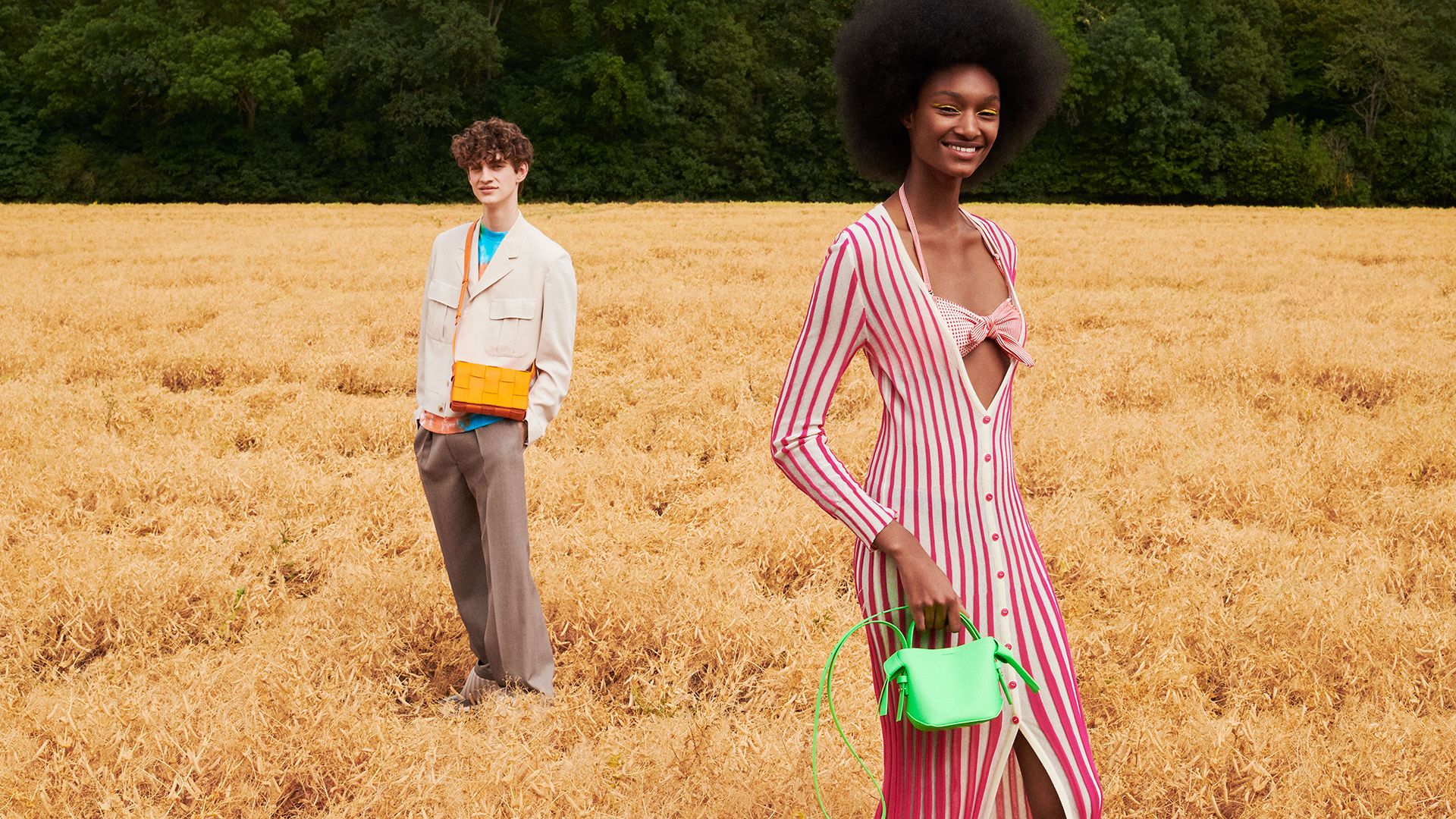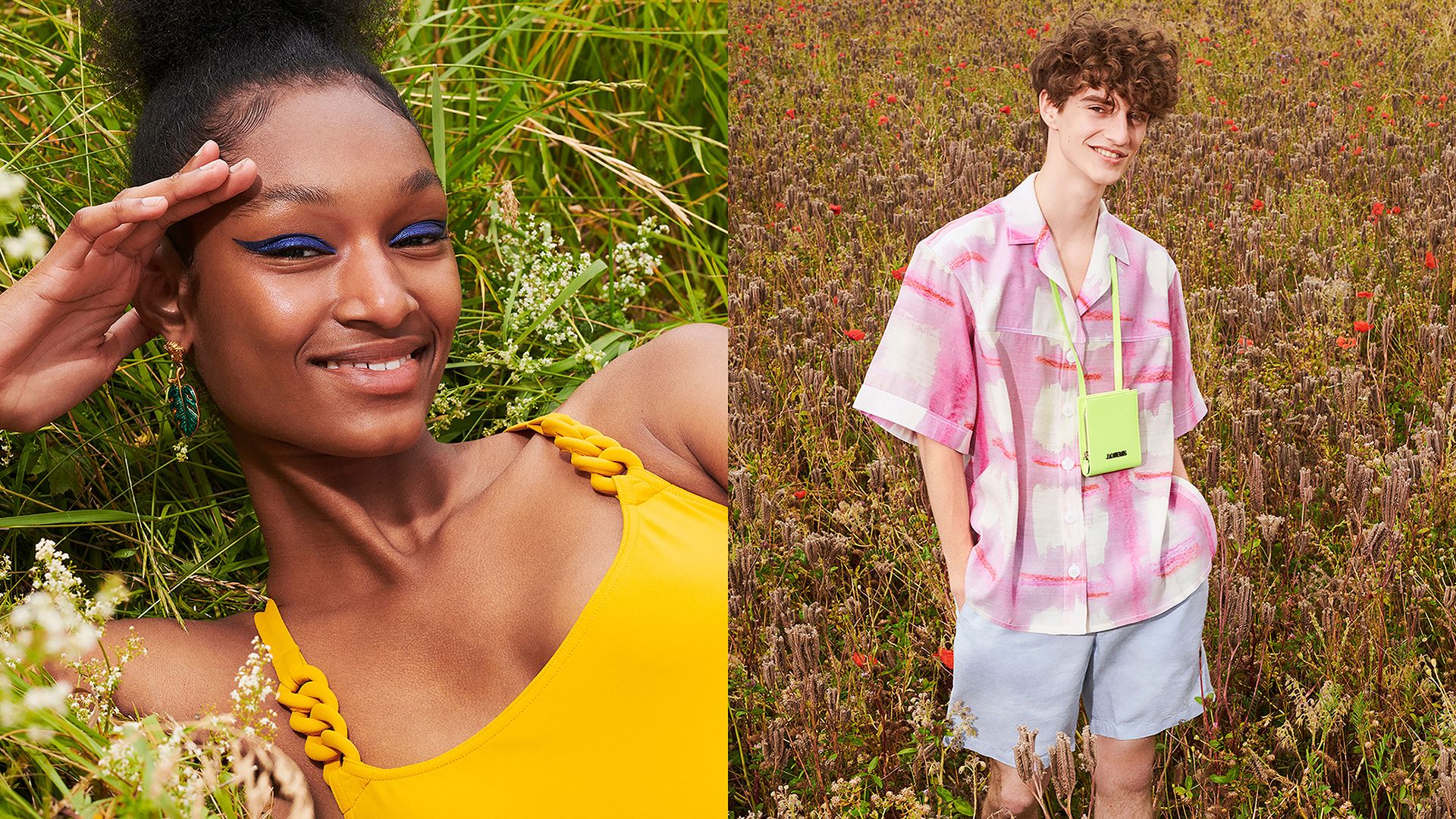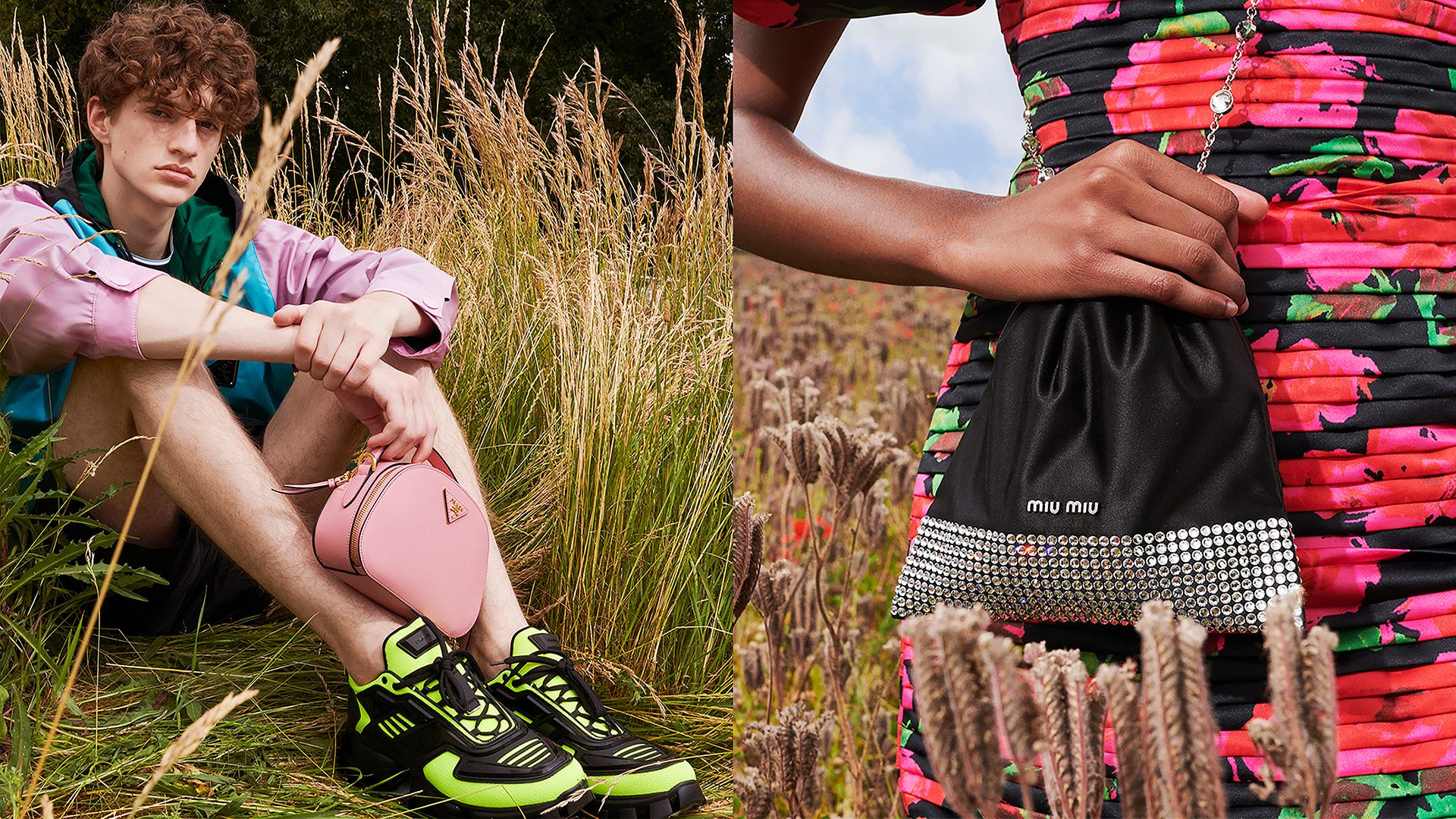-
FRENCH SCENERY: THE EVER-CHANGING GIFT OF NATURE
Creative and Style Director: Yann Weber. Photographer: Raffaele Cariou. Producer: Guillaume Folliero de Luna. Casting Director: Alexandre Junior Cyprien. Talent: Noémie Semedo Borges, Antoine Gouffaux. Hair Stylist: Olivier Schawalder. Makeup: Tiziana Raimondo.

Jacket with pockets in Beige Wool Paul Smith , Tailored Trousers in Wool and Silk Green Chloé
Her:Long dress in Pink cotton Jacquemus, Swimsuit bandeau pink Lemlem , Bag fluorescent in Green leather Acne Studios

Swimsuit Chainette nageur yellow Eres, Earrings Medusa Versace
Him:Shirt pink and white Jacquemus, Shorts in blue linen Orlebar Brown, Wallet in yellow leather Jacquemus
On 24th June 2019, across a brilliant pink carpet in the midst of lavender fields stretching as far as the eye can see, models paraded in Jacquemus' new creations. To celebrate his brand's 10-year anniversary, the designer chose to stage his "Coup de soleil" show deep in his native region Alpes-de-Haute-Provence in the south of France. A refreshing way of placing fashion at the centre of the French countryside, highlighting the beauty of Provençal landscapes, a year prior to the current events inducing us to rediscover France's regions.
Due to the health crisis, although the government announced that in July and August it was once again possible to fly in Europe, France remained the preferred destination for those lucky enough to take a holiday. An opportunity to enjoy a country whose natural attractions are particularly varied, from Brittany's Glénan archipelago turquoise waters, to the red rocks of the Estérel Massif, everlasting snow in the Alps and more.

Hooded parka green blue pink Prada, T-shirt blue Prada, Bag in pink leather Prada, Sneakers cloudbust thunder Prada, Swim shorts in black nylon Prada
Her:Dress with Balloon sleeves and Plumetis in Duchess Pink Satin Richard Quinn, Clutch Starlight in satin and crystals Black Miu Miu
How can this diverse geographical landscape be explained? Firstly, as the second largest country in Europe, France covers a vast area, spanning to four coastal areas (the North Sea, English Channel, Atlantic Ocean and Mediterranean Sea), and includes several overseas departments. It covers 1,000 kilometres in latitude, providing a wide range of varied climates. However, this diversity can also be attributed to its long geological history, producing many rocks and different subsoils. "France's geology has evolved in four stages," explains Georges Feterman, author of Pays et terroirs méconnus de France (Unknown Country and Terroir of France) (Delachaux et Niestlé, 2018). "300 million years ago, a large mountain range called "Hercynian" created France out of granite, forming a large V-shape made up of Brittany, the Massif Central, the Vosges and parts of the Alps. While the Vosges were still only islands, the sea deposited rocks throughout the rest of the country, mainly made up of limestone. In a third phase, 80 million years ago, the Alps began to emerge and change all these landforms. The Parisian basin and Burgundy are the result of these rocky elevations. Finally, more recently, rivers have formed over time, shaping our current landscapes."

The American West in the heart of France?
These successive transformations have resulted in three distinct areas in France today. The first, made up of granite, can be admired when visiting the Verdon gorges, the largest canyon in Europe carved out of a pink rock and offering a spectacular view. The second is limestone as found in Etretat in Normandy. These impressive cliffs, overlooking the English Channel, have inspired many painters, including the impressionist Claude Monet. In the Gironde, at the entrance to the Arcachon basin, the Dune du Pilat is another key piece of heritage, forming part of France's limestone mass. The third type of French landscape is mountainous. "But there is a place where these three areas of France meet," reveals the expert professor of natural sciences. This is the Cévennes, in the centre of the country, where we can admire the stunning gorges of Ardèche. For the full experience, Georges Feterman recommends starting your journey in the small towns of Florac and Meyrueis to immerse yourself in all the natural surroundings. "It's our very own American West", says the specialist with a smile.

However, our environment has not evolved on its own and human activity has, of course, had an influence on the landscape. "Man's impact dates back some 10,000 years, when we went from the Palaeolithic to the Neolithic period and men stopped being hunter-gatherers to become herders. From then on, everything changed with forests disappearing, making way for pastures. We went from closed to open environments, such as meadows." The most beautiful regions to take advantage of this imprint on civilisation are, for the most part, those associated with fine wines and excellent cheeses (champagne around Reims, red wine from the vineyards of Burgundy, cider along the Normandy coast, Roquefort cheese in the Causses, Comté cheese in the valleys of the Jura Massif and Beaufort cheese from Savoie mountain pastures).

Oversized Shirt dress with sequins in blue silk Lanvin, Bag in beige bamboo Cult Gaia
Him:Round Sunglasses Soave Amore Beige Gucci, Kaftan in Pink cotton LemLem
When, men and women began building cities around 3000 BC, they also created architectural masterpieces that integrated beautifully into their natural surroundings. An exceptional illustration is Mont-Saint-Michel, located between Brittany and Normandy and listed as a UNESCO World Heritage site. The Abbey of Saint-Michel, built in the 10th century, overlooks a rocky islet surrounded by a bay where the sky, sea and sometimes shifting sands merge on the horizon. Also, worth a mention is the impressive Pont du Gard, 48 metres high, dating back to the Antiquity period. The monument fits perfectly into its Mediterranean setting where eagles, herons and beavers cross paths.

A diversity to preserve
Is rapid urbanisation in the process of undermining this harmony and France's last natural havens? Not entirely. "Paradoxically, where cities have not been built, France's landscapes tend to revert to wilderness, i.e. there are fewer and fewer farmers to tame nature and forests are regaining ground," Georges Feterman highlights. The fact remains that the rise in temperatures on a global scale is upsetting natural areas, and scientists are observing how vegetation in the south is gradually moving northwards. "If we do nothing, the south of France is at risk of turning into a desert," warns Georges Feterman, also President of the A.R.B.R.E.S. association, whose mission is to promote and preserve the most extraordinary trees in the country. "However, two months of lockdown have proved how nature can reclaim its rights if humans are more reasonable," he continues.

Bikini top LemLem, Long dress in pink and white striped cotton Jacquemus
Him:Jacket with pockets in Beige Wool Paul Smith, T-shirt in printed cotton Tie Dye Multicolour Palm Angel, Tailored trousers in wool and silk green chloé, Shoulder bag orange Bottega Veneta
This summer, reducing the number of international tourist flights is helping to combat global warming and, in doing so, helping to protect France's natural environment. Holidaying locally can be just as enchanting. Visiting Le Mont-Saint-Michel, Marseille's calanques, the Île de Porquerolles and Lake Annecy, could be as inspiring as travelling to the other side of the world.